
views
Indian politics makes for strange bedfellows, none more so than the far-right Shiv Sena and the centre-left Congress-NCP alliance. Is the odd coupling purely a marriage of convenience, or does it represent a seismic shift in the ideological spectrum of our democracy?
A coalition of the centre-right BJP and the Congress-NCP would have been less unlikely than the Congress 'hand' clasping the Sena tiger's claw. But ideologies are not in play in Maharashtra. The drama is driven by the urge to power, a manifestly secular vice.
That the political opposites embraced just after the Supreme Court greenlighted the Ram Mandir, speaks volumes for the blurring of the communal-secular binary that has defined Indian politics since the early 1980s.
This period witnessed the ideological fluidity of the Congress, which is of long standing. From Nehru's Fabian tendencies and Indira Gandhi's socialist project to PV Narasimha Rao's rightward shift and Manmohan Singh's neoliberal socialism, the Congress has taken diverse positions.
The affirmation of the right as a dominant political force from the late 1990s thrust Sonia Gandhi into the embrace of the Left, leading to populist policies and a strident secular narrative skirting the edges of minority-ism. Her successor, Rahul Gandhi, mirrored the conservative-liberal oscillations of his late father.
This flexibility now stands the grand old party in good stead. It has not only partnered in a government in India's wealthiest state, but by allying with the hitherto untouchable Sena, has distanced itself from the never-ending debate on religious pluralism and minority rights.
The alliance was not an easy fix, least of all for the Congress. It was strongly opposed by tall leaders from the South, who are deeply invested in the party's secular identity and wary of 'saffronisation'. Only after it was pointed out that nothing other than forming a government could stave off a split in the state unit, did they agree.
The departure from hard secularism has as much to do with opportunism as the increasing acceptability of the BJP, even among liberal voters. The BJP has shown that it is not the atavistic sectarian party it is made out to be. Nor is it fascist in temperament, in that it has sought to exercise control over institutions, but not to destroy them.
As a result, the Congress’ secular-communal rhetoric has been largely ineffective. Stigmatised for a soft stance on terror and discredited for its record in office, both of which contributed to the ascension of the BJP, the Congress knows it cannot afford to take the ideological high ground.
What it can do is to free itself up from its obsessive concern with the RSS project and focus instead on the commissions and omissions of the NDA government. The BJP's loss of traction in the recent assembly elections should be proof enough of voters' disenchantment with a stuttering economy.
For a mainstream party to support a right-wing one is no longer unthinkable. The left-right accord in Maharashtra echoes similar alliances in Europe in the not-too distant past. In Greece, the radical-left Syriza formed a coalition with the conservative ANEL, while in Italy, the anti-establishment Five-Star Movement built an alliance with the far right League.
The architect of the Maharashtra coalition, Sharad Pawar, is the ultimate pragmatist. If he refused to ally with the Sena in the past, it was not for ideological reasons but for fear of alienating his vote base. Now, the boot is on the other foot. A coalition with the Sena offers an opportunity to win back the support of the Maratha elite and the Dalits, wooed respectively by the BJP and Prakash Ambedkar's VBA.
The displacement of the mahayuti's centre of gravity from the Shiv Sena to BJP was inevitable, given the latter's inexorable rise at the national level. From natural allies, they became natural rivals. The BJP will now doubtless target the Sena's core base, particularly if Pawar is unable to hold the coalition together.
On the one hand, the Maharashtra alliance and breaking of ranks by the Sena is the first crack in the right-wing edifice. On the other, it offers the Congress an opportunity to shift focus from the secular-communal dialectic to issues of public concern.
(The author is a senior journalist. Views are personal)



















Comments
0 comment